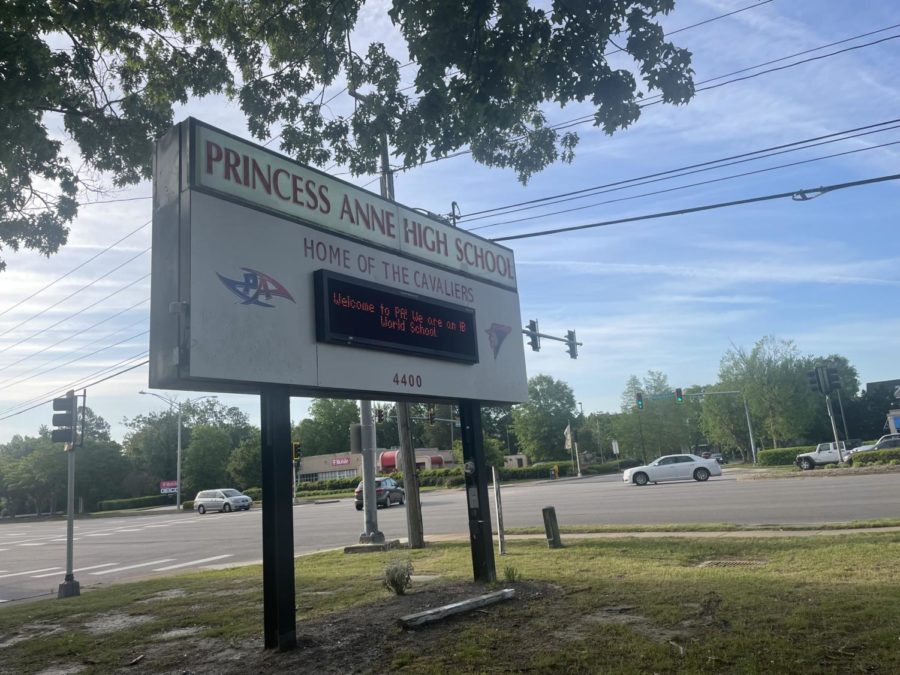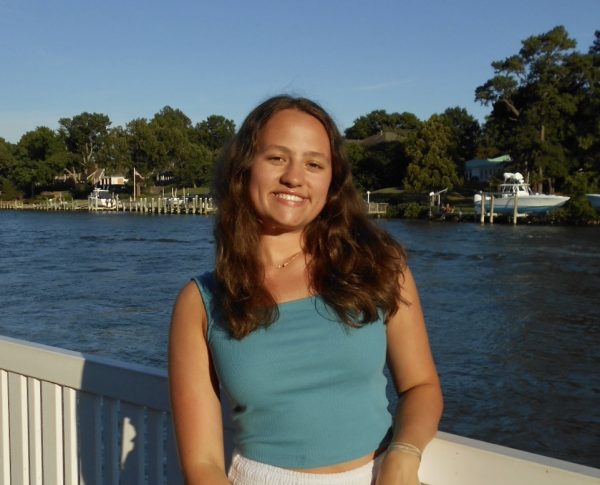The 4×4 schedule
April 26, 2023
This year, PA, along with the other 10 high schools in Virginia Beach, implemented a new system of scheduling classes known as “4×4”, replacing the previous A/B day schedule. Under 4×4, students remain taking classes in the block schedule (four classes a day, around 90 minutes each) as it was with A/B, but instead of switching between four classes one day to another four the next day, students take 4×4 classes every day, taking the whole class in a semester, instead of a full year. This switch to 4×4 classes is a significant change from its previous schedule, but as PA has shown throughout the years, it is no stranger to change.
Originally, PA operated on a “traditional” method of scheduling. All students had seven 50-minute classes a day, and not unlike the 4×4 schedule now, they would have the same classes every day. Then in 1994, PA joined Kempsville and Ocean Lakes to become the first high schools in Virginia Beach to implement the new block system of A/B day. This transition reworked how often students would attend each class, and gave them almost double the time they would normally spend in class, switching from 50 minute “bells” to 90 minute “blocks”.
English teacher Kelly Boyd was a student at PA while this transition from the traditional schedule to the block schedule was made and recalls how the change affected both students and teachers. A big difference Boyd recalls between the nineties and now, and something students these days can hardly comprehend, was how much “stuff” students had to carry around between classes. “Everybody was using their lockers back then. It was just what you did. Hardly anybody would consider not using their lockers, because we had so much stuff,” Boyd explains. “Especially when we had seven bells because we had seven classes worth of books to carry around.”
After the A/B schedule was implemented, Boyd believes a few problems with the traditional schedule, including how much stuff they had to carry around, were largely resolved. “I was relieved,” Boyd reflects. “I had fewer books to carry and I had two nights to do homework instead of one.” Although classes were no longer every day, Boyd describes how the 90 minute block was much more valuable than when it was 50 minutes previously. According to Boyd, having 50 minute classes “felt like I would pull out my stuff from my backpack, we would do one thing, and then we’d have to put it away to go [to our next class].”
Boyd recalls many students sharing her positive opinions on the change to A/B, although some students did not like how long they had to spend in class. “I think in my classes where students wanted to be there and they enjoyed the dynamic with the teacher, there was less pushback [on the new schedule],” Boyd explains. “But the students who didn’t enjoy being in school, they were like ‘I can’t believe we have to be [in class] for a whole block’.”
Since it was first implemented, Boyd explains that there have been minor changes to the block schedule. Largely, students spend less than 90 minutes in class now to allow for a 40 minute One Lunch, when it was just 20 minutes originally. A longer One Lunch allows for students to have the opportunities to make up work or receive help from their teachers, and have club meetings during the school day.
And just as the students of PA in the nineties adjusted to their new schedule, students this year are doing just the same, although some have already had experience with it.
Students in Virginia Beach were first introduced to the 4×4 schedule during the 2020-2021 school year, when many were taking online classes for almost the whole year. This decision to change to 4×4 classes while students were largely online was made to lower the classload while managing online classes, and when students did return in person, to reduce the amount of interaction between teachers and students to stop the spread of Covid-19, according to VBCPS Chief Schools Officer, Matthew Delaney.
Delaney explains that once schools had a taste of the 4×4 schedule, some wanted to implement it right away even after it was no longer necessary under the circumstances of Covid. The time during the following school year, Delaney describes, was used to take in opinions of what worked and what didn’t under 4×4. “We gave surveys out to teachers, principals, and others to say ‘are we ready to look at this change?’ What were the positives and challenges of the 4×4?”
Delaney describes how PA specifically was “loud and clear” when expressing what worked for the school with 4×4. Upper level IB classes, AP classes, and fine arts like orchestra, band, and chorus all were classes that remained in the A/B schedule because the timing of exams and assessments required the classes to be yearlong.
Because of this, Delaney describes this year’s current schedule as “not a strict 4×4”, instead it is a “hybrid or flexible schedule,” where students can take a mix of 4×4 and A/B classes. This hybrid is what many in PA end up doing.
In a survey conducted by The Page, 54 percent of students this year take a mix of 4×4 and A/B classes, 34.9 percent take all 4×4 classes, and 11.1 percent take all A/B.
Even though a majority of students still have at least one A/B class, Delaney explains that implementing 4×4 classes allows for more flexibility “to get to a more of a high school situation that fits the needs of our students. That increases more opportunities for them to get involved in internships, work-based learning [and] take advanced courses that the previous schedule kind of boxed [students] in.”
And so for the past seven months, PA’s students have tried out this new schedule. At the end of January, first semester classes ended and students started up their second round of classes.
Freshman Emmie Furman has a mix of 4×4 and A/B classes and believes that a problem with her 4×4 classes is that absences can be a bigger issue than with A/B, because 4×4 classes are every day. “Let’s say you have a bunch of assignments those days you aren’t there,” Furman proposes. “Instead of missing a couple classes like [A/B], you have a whole week to catch up on.” But Furman also sees advantages in having classes every day. “You can learn more and you can catch up right where you were the previous day,” Furman explains.
According to sophomore Danny Florkowski, taking all 4×4 classes is “horrible” but he can see some possible benefits. “It’s not fun,” Florkowski describes. “I’d rather have all my classes together, but on the bright side, I don’t have to deal with one teacher that I don’t like for the [whole] year.” A specific problem Florkowski believes that 4×4 classes creates is the gap that is formed during the period of time when a type of class isn’t taken. “You can go a whole semester without having math and then come back the next year and not remember much about it.”
Florkowski’s opinion about having a long time between classes is shared by many respondents of The Page’s survey about 4×4 classes, especially his concern about math classes. For example, In this first year of implementing 4×4 classes, many students after ending their math class in June 2022, would have two possibilities of when they would take it again. If their math class was made 4×4, they would either take it that following September, finishing in January 2023 and not taking another math class until September 2023, leaving a seven month gap, or even possibly not taking it again until January 2024, leaving a whole year in between. Or, after finishing their math class in June 2022, students could again have a seven month gap, not taking their math class until January 2023.
Among a few minor issues math teacher Lauren Vento sees with 4×4 classes, she also sees a problem with a learning gap. “I was worried about the break that some students would have,” said Vento. Vento explains that along with world languages, which requires constant practice to retain knowledge in the area, math is a subject that especially needs consistent application.
Now after experiencing a full semester of teaching multiple 4×4 classes, Vento is able to identify how teaching with the new schedule differs from what she is used to. “[4×4] doesn’t particularly change how we teach,” Vento explains. “We [have] to be more conscious of what we send home because you have obviously less time to complete it.” Instead of having two nights to complete homework, as is with A/B classes, students are usually assigned work every night to complete. “But I don’t think it really changes the ‘how’ in what we do in class.” Vento explained while there were resources available to help teachers with the transition to 4×4, she believes that there weren’t many teachers who were deterred by the change.
Senior Izzie Grandela only has one 4×4 class because of the three AP classes she is taking along with a special program class, all which are A/B. Grandela has enjoyed the balance between A/B and 4×4 this year “It serves its purpose with certain classes,” Grandela believes. “There are classes where I’m good with having that class every other day because sometimes they have a little more work so it’s nice to have that spacing. But I also like the 4×4 because the classes go by faster so I don’t have to worry about it the next semester or I don’t have to worry about it until that next semester.” Grandela recalls that when 4×4 was first introduced, people she spoke with had mixed feelings about it because on some level, they were confused about what it would be like mixing with A/B classes. “I feel like people are more accustomed to it.”
With some of the issues in mind, Delaney and VBCPS acknowledge that “we are not done.”
“Adjustments are going to continually be made based on what we’re looking at in terms of student selection,” Delaney explains regarding 4×4 classes, and how they are put into practice for students. Regarding the faster pace of 4×4 classes, issues with absences and the learning gap created because of 4×4 scheduling, Delaney says that “Those challenges are challenges that we are clearly aware of, and we’re not surprised by. It’s our first year and people do not like change.”
PA, just as it did when transitioning from the “traditional” schedule to A/B under the block schedule, is already making adjustments. While upper level (DP) IB classes were automatically left in the A/B schedule, now MYP classes will become A/B for the 2023-2024 school year.
Delaney shares that problems with the 4×4 also will improve once students are more aware of the opportunities students can take advantage of under 4×4 scheduling and to figure out “their journey.”
“We have no plans to go to a strict 4×4 schedule,” continues Delaney. “Next year you will probably see more core content classes that are on the A/B as well. So you’ll see a mix of the 4×4 and A/B so we can pair some of those AP classes with a non-AP content class, where many schools did not have those pairings. The reality is what is school going to look like in 15-20 years and do we have a model that supports what true education looks like?”
Delaney also describes all that can be possible regarding learning across the school system and how with technology, students can make possibilities now, a reality in the future. “We’re continually looking at are we maximizing the opportunities for students to be ready for the world that’s out in front of them and are we utilizing staff effectively to do that? One phase of that was taking a look at our schedule.”





